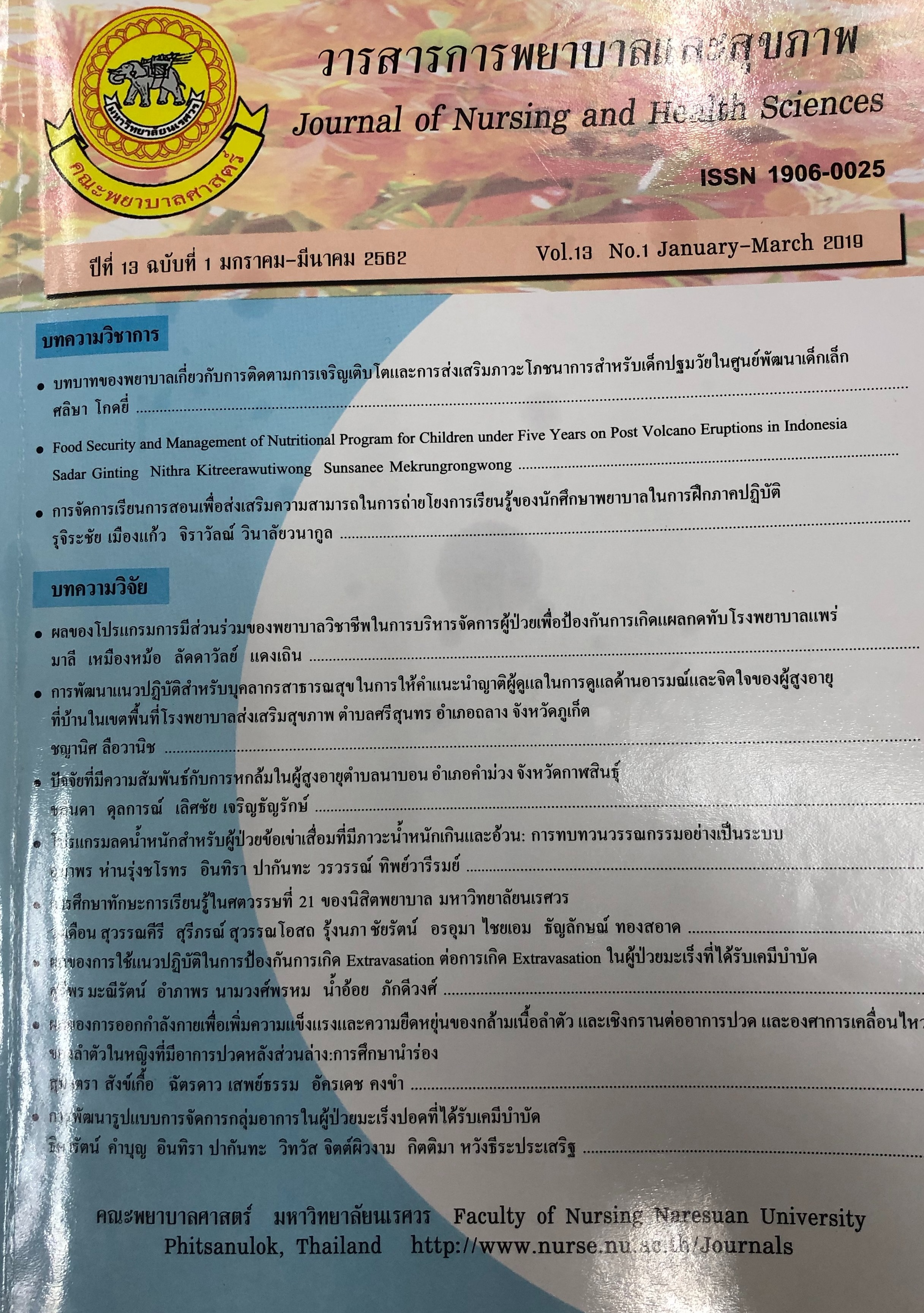ผลของการออกกำลังกายเพื่อเพิ่มความแข็งแรงและความยืดหยุ่นของกล้ามเนื้อลำตัวและเชิงกราน ต่ออาการปวดและองศาการเคลื่อนไหวของลำตัวในหญิงที่มีอาการปวดหลังส่วนล่าง:การศึกษานำร่อง
Main Article Content
บทคัดย่อ
การวิจัยมีวัตถุประสงค์เพื่อศึกษาผลของโปรแกรมการออกกำลังกายเพื่อเพิ่มความแข็งแรงและ ความยืดหยุ่นของกล้ามเนื้อลำตัวและเชิงกราน และยังศึกษาผลของการออกกำลังกายด้วยโปรแกรมดังกล่าว ต่ออาการปวดหลังส่วนล่างและองศาการเคลื่อนไหวของลำตัว โดยศึกษาในอาสาสมัครเพศหญิงที่มีอาการ ปวดหลังส่วนล่าง อายุระหว่าง 20-30 ปี จำนวน 9 คน อาสาสมัครทุกคนได้รับโปรแกรมการออกกำลังกาย เพื่อเพิ่มความแข็งแรงของกล้ามเนื้อหน้าท้องมัดลึก และกล้ามเนื้อเหยียดสะโพก ร่วมกับการออกกำลังกาย เพื่อเพิ่มความยืดหยุ่นของกล้ามเนื้องอสะโพก และกล้ามเนื้อหลัง เป็นเวลา 4สัปดาห์ ทั้งนี้ระดับอาการปวดหลัง ส่วนล่าง องศาการเคลื่อนไหวของลำตัว ความแข็งแรง และความยืดหยุ่นของกล้ามเนื้อบริเวณลำตัวและเชิงกราน ทั้ง 4 กลุ่มถูกวัดทั้งก่อน และหลังได้รับโปรแกรมการออกกำลังกาย สำหรับข้อมูลที่ได้นั้นถูกนำมาคำนวณ ทางสถิติด้วยวิธีวิลคอกซันหาค่ามัธยฐาน และพิสัยระหว่างควอไทล์ซึ่งผลการวิจัยพบว่าอาการปวดหลังส่วนล่าง ลดลงอย่างมีนัยสำคัญทางสถิติ (p < 0.05) และความแข็งแรงของกล้ามเนื้อหน้าท้องมัดลึก กล้ามเนื้อเหยียดสะโพก ความยืดหยุ่นของกล้ามเนื้องอสะโพกกล้ามเนื้อหลัง รวมถึงองศาการเคลื่อนไหวของลำตัวเพิ่มขึ้นอย่างมี นัยสำคัญทางสถิติ (p < 0.05) จากการวิจัยอาจสรุปได้ว่าโปรแกรมการออกกำลังกายสองรูปแบบเพื่อเพิ่มความ แข็งแรง และความยืดหยุ่นครบทั้ง 4 กลุ่มกล้ามเนื้อบริเวณลำตัวและเชิงกรานสามารถลดอาการปวดหลังส่วนล่าง เพิ่มองศาการเคลื่อนไหวของลำตัว เพิ่มความแข็งแรง และความยืดหยุ่นของกล้ามเนื้อในผู้ที่มีอาการปวดหลัง ส่วนล่างได้ใน 4 สัปดาห์
Article Details
References
Amabile, A. H., Bolte, J. H., & Richter, S. D. (2017).
Atrophy of gluteus maximus among women with
a history of chronic low back pain. PLoS One,
(7), 1-12.
Batsis, J. A., & Buscemi, S. (2011). Sarcopenia,
sarcopenic obesity and insulin resistance. Medical
complications of type 2 diabetes (pp. 233-
. Croatia InTech.
Been, E., & Kalichman, L. (2014). Lumbar lordosis.
The spine journal, 14(1), 87-97.
Brown, N., Bubeck, D., Haeufle, D. F. B., Weickenmeier,
J., Kuhl, E., Alt, W., & Schmitt, S. (2017). Weekly
time course of neuro-muscular adaptation to
intensive strength training. Frontiers in
Physiology, 8, 1-6.
Candotti, C. T., Noll, M., Marchetti, B. V., Rosa, B. N. d.,
Medeiros, M. d. G. S., Vieira, A., & Loss, J. F.
(2015). Prevalence of back pain, functional
disability, and spinal postural changes. Fisioter
Mov, 28(4), 711-722.
Cho, H. Y., Kim, E. H., & Kim, J. (2014). Effects of the
CORE exercise program on pain and active
range of motion in patients with chronic low
back pain. Journal of Physical Therapy Science,
(8), 1237-1240.
DeRosa, C., & Porterfield, J. A. (2007). Anatomical linkages
and muscle slings of the lumbopelvic region.
In Vleeming A, Mooney V, Stoeckart R, (ed.)
Movement, stability & lumbopelvic pain: integration
of research and therapy. (pp. 47-62)
New York: Churchill Livingstone (Elsevier).
Descarreaux, M., Normand, M. C., Laurencelle, L., &
Dugas, C. (2002). Evaluation of a specific home
exercise program for low back pain. Journal of
Manipulative and Physiological Therapeutics,
(8), 497-503.
Frana, F. R., Burke, T. N., & Caffaro, R. R. (2012).
Effects of muscular stretching and segmental
stabilization on functional disability and pain
in patients with chronic low back pain: A
randomized, controlled trial. Journal of
Manipulative and Physiological Therapeutics,
(4), 279-285.
Frana, F. R., Burke, T. N., Hanada, E. S., & Marques,
A. P. (2010). Segmental stabilization and
muscular strengthening in chronic low back
pain-a comparative study. Clinics (Sao Paulo),
(10), 1013-1017.
Jeong, U.-C., Sim, J. H., Kim, C. Y., Hwang-Bo, G., &
Nam, C. W. (2015). The effects of gluteus muscle
strengthening exercise and lumbar stabilization
exercise on lumbar muscle strength and balance
in chronic low back pain patients. Journal of Physical
Therapy Science, 27(12), 3813 - 3816.
Key, J. (2010). Back pain: A movement problem. Chaina:
Churchill Livingstone.
Kisner, C., & Colby, L. A. (1996). Therapeutic
exercise: Foundations and techniques (6th ed.).
Philadelphia: F.A. Davis.
Kumar, A., Zutshi, K., & Narang, N. (2011). Efficacy
of trunk proprioceptive neuromuscular
facilitation training on chronic low back
pain. International Journal of Sports Science and
Engineering, 5(3), 174-180.
Kumar, T., Kumar, S., Nezamuddin, M., & Sharma, V.
P. (2015). Efficacy of core muscle strengthening
exercise in chronic low back pain patients.
Journal of Back and Musculoskeletal Rehabilitation,
(4), 699-707.
Ma, V. Y., Chan, L., & Carruthers, K. J. (2014).
Incidence, prevalence, costs, and impact on
disability of common conditions requiring
rehabilitation in the United States: Stroke, spinal
cord injury, traumatic brain injury, multiple
sclerosis, osteoarthritis, rheumatoid arthritis,
limb loss, and back pain. Archives of Physical
Medicine and Rehabilitation, 95, 986 - 995.
Malai, S., Pichaiyongwongdee, S., & Sakulsriprasert,
P. (2015). Immediate effect of hold-relax
stretching of iliopsoas muscle on transversus
abdominis muscle activation in chronic
non-specific low back pain with lumbar
hyperlordosis. Journal of the Medical Association
of Thailand, 98(5), s6 - 11.
Winters, M. V., Blake, C. G., Trost, J. S., Marcello-
Brinker, T. B., Lowe, L., Garber, M. B., &
Wainner, R. S. (2004). Passive versus active
stretching of hip flexor muscles in subjects with
limited hip extension: A randomized clinical
trial. Physical Therapy, 84(9), 800-807.
Nourbakhsh, M. R., Arabloo, A. M., & Salavati, M.
(2006). The relationship between pelvic cross
syndrome and chronic low back pain. Journal of
Back and Musculoskeletal Rehabilitation, 19(4),
-128.
Page, P., & Ellenbecker, T. S. (2003). The Scientific
and clinical application of elastic resistance.
(pp. 290). Human Kinetics.
Puntumetakul, R., Yodchaisarn, W., Chatchawan,
U., Peungsuwan, P., Eungpinichpong, W.,
Nilphanomchai, R., & Leerattana, S. (2015).
Immediate effects between core stabilization
exercise and strengthening exercise on postural
balance in patient with chronic non-specific low
back pain. Journal of Medical Technology and
Physical Therapy 27(3), 320-329.[In Thai].
Rajalakshmi, D., & Kumar, N. S. S. (2012).
Strengthening transversus abdominis in
pregnancy related pelvic pain: The pressure
biofeedback stabilization training. Global
Journal of Health Science, 4(4), 55-61.
Schlink, M. B. (1996). Muscle imbalance patterns
associated with low back syndromes, In Watkins
R.G., (ed.) The spine in sports (pp.146-156)
St Louis: Mosby.
Vera-Garcia, F. J., Grenier, S. G., & McGill, S. M. (2000).
Abdominal muscle response during curl-ups on
both stable and labile surfaces. Physical
Therapy, 80(6), 564-569.
Winters, M. V., Blake, C. G., Trost, J. S., & Wainner, R.
S. (2004). Passive versus active stretching of
hip flexor muscles in subjects with limited hip
extension: a randomized clinical trial. Physical
Therapy, 84(9), 800-807.
Yaruang, N., & Intahphuak, S. ( 2016). Effects of stretching
exercise program on low back pain in rice
farmers. Journal of The Royal Thai Army Nurses,
(3), 73-81. [In Thai].
Yoo, Y. D., & Lee, Y. S. (2012). The Effect of core
stabilization exercises using a sling on pain
and muscle strength of patients with chronic
low back pain. Journal of Physical Therapy
Science, 24(8), 671-674.

